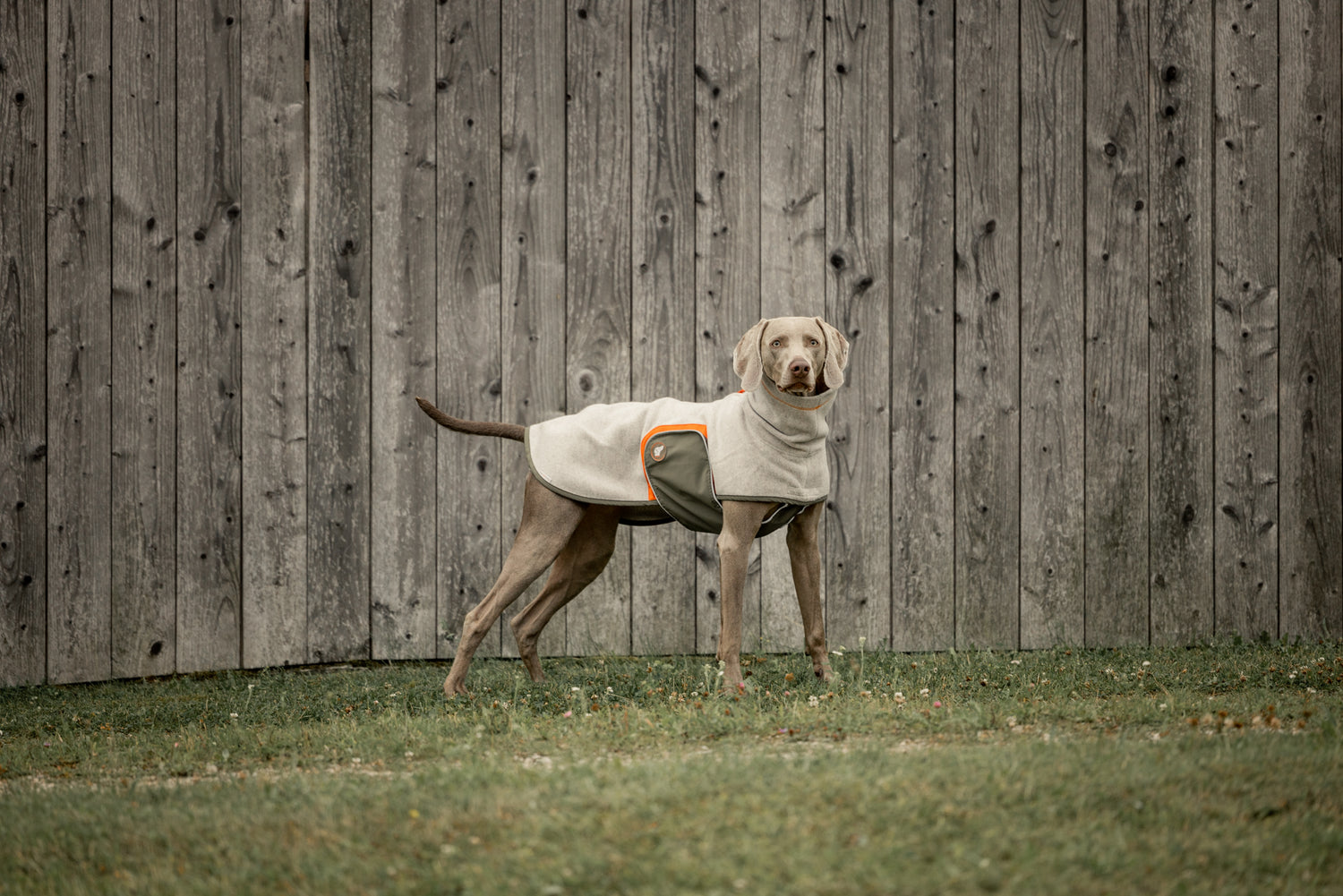Do dogs need dog coats?
Unfortunately, there is no general answer to this question. In any case, it can be said that dog coats are more than just an accessory. Depending on climatic conditions, dogs with thinner coats and little or no undercoat may benefit from dog coats. With a dog coat you can keep your four-legged friend warm and dry and protect him from hypothermia.Dogs with undercoats can also benefit from dog coats. A dog coat also ensures that the dog's important muscle groups are kept warm, thereby reducing arthritis-related pain in wet and cold conditions. Dog coats can therefore be very beneficial for older or sick dogs.
Which dogs need dog coats?
Dogs with short fur or no undercoat freeze more easily, especially in winter. These include, for example, the following dog breeds: Boxer, Dalmatian, Weimaraner, Magyar Vizsla, Great Dane, Doberman, French Bulldog, Rhodesian Ridgeback, Short-haired Dachshund, Whippet, Greyhound and many other dog breeds.Small dogs tend to have thinner coats than large dogs and often have less body fat than large dog breeds, which means they cool down more quickly and are more susceptible to cold.
It is therefore advisable to wear a coat when walking on cold days or when spending time outdoors where the dog does not move much. Even if you leave your dog in the car in cold temperatures, it may be advisable to put a coat on him beforehand.

Does my dog need a coat?
Whether your dog also needs a coat is a very individual decision. This decision depends on the breed, coat condition, age and general health of your dog. Certain illnesses in the dog or the administration of certain medications can cause the dog to react more sensitively to cold or weather influences.
In such cases, a dog coat can help the dog feel more comfortable and heal faster. A dog coat can also help the animal feel more comfortable and less stressed outdoors, which in turn can promote recovery.
The following questions will help you decide whether your dog needs a coat:
If you can answer yes to most of these questions, you should consider putting a coat on your dog on cold days.
How can you tell if your dog is cold?
You can often tell if your dog is cold when he begins to stand up his fur on his back and rump and tries to "roll up" his rump.By raising their fur, dogs try to increase their layer of insulation. For this purpose, dogs often tuck their tails between their hind legs or adopt a generally stiff posture. By pinching their tails, dogs try to reduce the surface area of their bodies. So if you observe these signs in your dog on cold days, it is advisable to put a coat on him or bring him into the warmth.
Which dog coats are there?
There are many different types of dog coats:

A dog winter coat is a lined dog coat designed to protect your dog from cold, wind and snow. It should have a sufficiently large insulation layer, be made of water-repellent or, better yet, waterproof material, fit comfortably and leave enough space for your dog to move freely. It should also be easy to put on and clean.
A dog raincoat is usually made of water-repellent or waterproof material. Its primary purpose is to protect your dog from moisture and moisture. The dog raincoat should be cut so that it covers the entire body of the dog including the rump and thighs. There are often reflective elements to increase the dog's visibility in low light conditions. If it's cold outside, the raincoat should be cut wide enough so that your dog can wear a loop, a scarf or even a dog sweater underneath.
A dog sweater is primarily intended to protect the dog from cold and wind. It should be made of a soft and comfortable material that allows the dog full freedom of movement. A good dog sweater should also fit snugly to prevent heat loss, but not be too tight so as not to restrict the dog's freedom of movement. It should also be easy to put on and clean. A dog sweater is a practical companion for the winter, but also for the cold morning or evening walk in spring or autumn.
A dog bathrobe should be made of absorbent material that absorbs excess water and moisture after bathing, swimming or showering. A high-quality terry cloth fabric is ideal. It should be cut sufficiently wide and, above all, be quick to put on. Because when your dog gets out of the bath with a fresh shower, he should be able to shake himself out thoroughly in his dog bathrobe. Some dog bathrobes have a long collar or hood so that the dog's head and ears can be dried comfortably. Your dog bathrobe should also be machine washable.
What should you consider when buying a dog coat?
If you have decided on a dog coat, you should first make sure that it fits your dog well and comfortably. The cut is primarily responsible for this. Your dog coat should be cut so that it adequately covers your dog but does not restrict his freedom of movement. Dog coats with rubber loops for the hind legs are not recommended as they chafe on the legs or thighs when moving.The coat should also fit your dog perfectly in terms of both chest circumference and back length. The chest circumference is measured from the side at the highest point of the chest. Under no circumstances should the coat be too tight at this point.
When choosing the right back length, the measurement between the end of a loose-fitting collar and the base of the tail is crucial. It is important that the “airline” between these two points is not simply measured. It is best to place a flexible measuring tape on your dog's back and measure this distance including the curve of the back line. When measuring, your dog should adopt as relaxed a posture as possible and not keep his head down. The correct coat length ensures that the coat lies securely over the dog's rear even when moving and that your dog is also protected when moving.
What should you consider when choosing the right size?
If your dog is between two coat sizes, we recommend choosing the next larger size.With THEO & EMMA's modular system you can individually adapt the coat size to your dog. By selecting sizes separately according to back length and chest circumference, you can adapt your dog coat perfectly to your dog's body measurements.
My dog needs a coat – how do I get him used to it?
Dogs differ not only in their coat texture, appearance and size, but also in their character. While some four-legged friends are open to everything and go through life fearlessly, there are also dogs who are rather skeptical about new things. If you have a fearful dog, you may have to get him used to the raincoat or winter coat for dogs.
Fortunately, many dogs jump over their shadows when they get a treat. In this case, it's easy for you and you can associate the unfamiliar coat with a positive stimulus. First place the coat next to the dog and let him sniff it thoroughly. As soon as your dog approaches the coat, reward him with a treat. If your dog has a positive association with the coat, you can soon put it on him.
Once your dog has experienced how comfortable a dog coat is and what advantages a rain or winter coat has for him, he will no longer want to be without it in the future.


